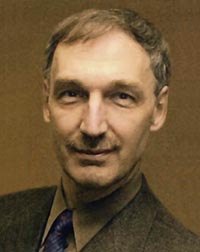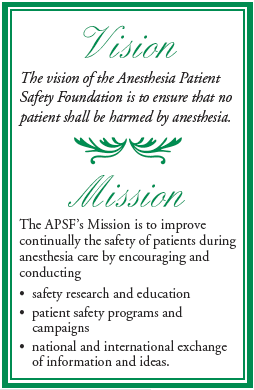
Richard C. Prielipp, MD, Chair, APSF Committee on Education and Training
The Committee on Education and Training is composed of 16-20 members of diverse professional backgrounds and medical expertise, including anesthesiologists (affiliated with the ASA), surgeons (ACS), nurse anesthetists (AANA), anesthesiologist assistants (AAAA), pharmacists (ASHP), and human factors/simulation scientists (PhD scientist-members of the ASA). The goal of this APSF Committee is to illuminate, communicate, and disseminate information vital to patient safety in the perioperative period. We utilize a host of communication media to stay connected with our constituents, including the APSF Newsletter, the APSF booth at the annual ASA and IARS meetings, reports and summaries of special safety symposia, and the ever-expanding APSF website (www.apsf.org). Most recently, the APSF has linked with Anesthesia & Analgesia as the organization’s new scientific journal, and a new section editor for Patient Safety, Dr. Sorin J. Brull, will work closely with its editor-in-chief.
Our target audience includes clinical anesthesia providers, students of anesthesiology, anesthesiology and safety scientists, anesthesiologist assistants and OR technicians, acute care pharmacists, and corporate vendors who provide us with reliable medical monitors, anesthesia machines, and novel pharmaceutical agents. In addition, our topics and discussions are frequently relevant to the nation’s risk managers, society officers such as the Board of Governors of the American College of Surgeons, the liability insurance industry, the Joint Commission, the FDA, and congressional staffers responsible for health care information. The past, present, and future contributions of the Committee are highlighted below.
THE PAST
Improvements in Education, Training, and Monitoring
The improvements in patient safety have been the result of the sustained focus of APSF leaders and committee members on the science of safety in medicine. Today, anesthesia providers are highly-trained, tested, certified and, increasingly, recertified to standards that include safety practice guidelines. We enjoy record numbers of highly-trained, skilled, and certified physicians, nurse anesthetists, and anesthesiologist assistants working today in the United States. In the last 3 decades, the combined efforts of these skilled providers, along with the tireless energies of APSF members, have resulted in a decline in anesthesia-related deaths from 1 in 15,000 anesthetics to 1 in 250,000 today. With healthy patients, the risk is even lower—a rate of “defects” that approaches Six Sigma levels of reliability.
ASA Patient Safety Videotape Series
The ASA has produced a series of patient safety videotapes, at a cost of $50,000 per topic, for use in anesthesiology residency and SRNA training programs. The videotapes are also a rich source of institutional and departmental continuing education programs. A total of more than 30 videotapes have been produced and distributed on various topics, including: Difficult Airway, Central Venous Catheters, Infection Control, Crisis Management, Fatigue: Implications for the Anesthesiologist, Production Pressure in Anesthesiology, Medication Errors, and Pediatric Safety. While this medium is now dated, the contribution of this series to education and training is immeasurable.
Past Recipients of the APSF Ellison C. Pierce, Jr., MD, Research Award for Best Scientific Exhibit at the Annual ASA Meeting
| Year | Primary Investigator(s) | Exhibit |
|---|---|---|
| 2007 | Your Name goes here! | To be determined! |
| 2006 | Roger Johnson, CBET, Chad Vandrovec, MD, Steven F. Bulz, MD, Neil E. Farber, MD, PhD, Gregoary Diciaula, BA
Children’s Hospital of Wisconsin, Milwaukee, WI |
“Anesthesia Machines: Mishaps and Mistakes”
This is a multimedia format that highlighted components of the anesthesia machine, and how to avoid machine related mishaps. |
| 2005 | Brett L. Arron, MD, Richard Gillerman, MD, James E. Peacock, RN
Rhode Island Hospital, Providence, RI |
“MacIntosh and IBM-compatible Laptop-based Videography of Airway Management for teaching airway management and record keeping” |
| 2004 | Susanne Shamsolkottabi, MD
University of Minnesota Medical School, Minneapolis, MN |
“Medication Error Prevention”
A visual and PowerPoint presentation. |
| 2003 | Prof. Pierre A. Diemunsch
C.H.U. Hautepierre, Strasbourg, France |
“Virtual Model for Navigation in the Upper Airway as a Teaching Tool for Fiberoptic Intubation” |
| 2002 | Not Awarded | N/A |
| 2001 | Sem Lampotang, PhD
University of Florida, Gainesville, FL |
“WEB-based ‘virtual anesthesia machine,’ which is an interactive, computer simulation of the anesthesia machine and ventilator.” |
| 2000 | John Schaefer, III, MD
UPMC Health System, Pittsburgh, PA |
“Simulation Based Training in Applying the ASA Difficult Airway Algorithm” |
| 1999 | Elizabeth C. Behringer, MD
Veterans Affairs Healthcare System, Long Beach, CA |
“The Cuffed Oropharyngeal Airway (COPA) – A Review and Demonstration of its Use in Fiberoptic Intubation” |
| 1998 | Maya Suresh, MD, David Ferson, MD
Northwestern University Medical School, Chicago, IL |
“Laryngeal Mask Airway: Its Contributions to Anesthesia Practice and Airway Management” |
| 1997 | Dietrich Gravenstein, MD, Sem Lampotang, PhD, Richard Melker, MD,University of Florida, Gainesville, FL |
“Fiberoptic Imaging Stylet for Intubation” |
The APSF Ellison C. Pierce, Jr., MD, Research Award for Best Scientific Exhibit at the Annual ASA Meeting
A subcommittee (committee chair, along with members of the ASA, AANA, ASHP, and AAAA) reviews approximately 50 exhibits each year at the Annual ASA Meeting for the Ellison Pierce Award. The awardees and their exhibit are featured in the winter edition of the Newsletter after the meeting. The 10-year history of awards is summarized in the table on page 4. We hope to see you compete for this prestigious award in San Francisco this coming year!
THE PRESENT
APSF Safety Grants Expanded to Specifically Include Education
The Education Committee worked with the APSF leadership to expand the focus of the APSF Safety Grants in 2004 to advocate specifically for
areas of . . . educational content . . . which include new clinical methods for prevention and/or early diagnosis of mishaps; evaluation of new and/or re-evaluation of old technologies for prevention and diagnosis of mishaps; identification of predictors of patients and anesthetists at increased risk for mishaps; development of innovative methods for the study of low-frequency events; methods for measurement of cost effectiveness of techniques designed to increase patient safety; innovative methods of education and training to improve safety; specific or thematic development of educational content or methods with application to patient safety; and development or testing of educational content to measure and improve safe delivery of perioperative anesthetic care.
Research grants that include the following attributes are of special interest:
- Development or testing of educational content to measure, develop, and improve safe delivery of anesthetic care during the perioperative period; and
- Development, implementation, and validation of educational content or methods of relevance to patient safety.
What Are the Current Concerns of Anesthesia Providers?
The Education Committee sampled and recently summarized the areas of ongoing safety concerns of anesthesia providers. Indeed, because of the work of the APSF over the last 20 years, all members are well-educated and focused on topics relevant to patient safety. The extensive (but not exhaustive) list identified by committee members includes

- Medication “syringe swap” or “drug swap” with look-alike ampoules
- Definition and interpretation of FDA Black Box Warnings
- Methods to optimize OR teamwork
- Optimal labels (labeling procedures) of all medications
- Perioperative MD/RN/Team Communication
- Production pressure
- Obstructive sleep apnea, opioids, and respiratory depression
- The anesthesia machine checkout
- Correct surgery policies (the OR “time out”)
- Awareness during general anesthesia
- Anesthesia “hand-offs”
- Provider fatigue (including call obligations)
- Fires in the OR
- Audible alarms
- Desiccants: toxic metabolites, CO, and other issues
- Beta-blocker protocols (prevention of
- perioperative MI)
- Neuraxial anesthesia and anticoagulants
- Antibiotic surgical prophylaxis: dose, timing, compliance
- Optimal perioperative glucose management
- Catheter-related sepsis: aseptic technique in the OR
- Parents’ presence during pediatric anesthesia induction?
- Difficult airway management/ASA difficult airway algorithm
- Positioning related injuries (neuropathy and tissue injury)
- Update on AHA / CPR algorithms
- NPO adult and pediatric recommendations
- DVT prophylaxis
- Normothermia and temperature maintenance
- Distractions/noise/music/reading in the OR
- Anesthesia in out-of-OR or office-based locations
- Sedation by non-anesthesia providers
- Training/certification for users of new anesthesia equipment
- Certification and documentation of competence
- Impaired practitioners (drugs, ETOH, etc.)
- Locked OR carts/access to emergency drugs
- The role of the patient (and family) in Patient Safety concepts
- Design of the new OR and anesthesia workstations
- Other, yet to be determined safety issues!
VAM: The Virtual Anesthesia Machine
The free Virtual Anesthesia Machine (VAM) simulation is the flagship transparent reality simulation developed by a team led by Sem Lampotang, PhD, and supported by the Department of Anesthesiology at the University of Florida College of Medicine and multiple APSF Safety grants. First implemented in 1999, the interactive and illustrated simulation of a generic anesthesia machine with an oxygen-driven bellows ventilator now includes legends in 23 languages and 6 medical gas color codes. Users can interact with controls and settings of the anesthesia machine via a pointing device such as a mouse or trackball. Audible cues enhance the realism of the learning experience. The VAM website at http://vam.anest.ufl.edu/wip.html includes a free 60-page APSF anesthesia machine workbook that provides structured learning exercises for self-paced learning and the APSF simulation of the 1993 FDA anesthesia machine pre-use checklist. In a study with premed students, transparent reality simulation (where the inner processes of a system are made visible, e.g., gas flow) provided better 24-hour knowledge retention on 3 of 5 objective measures of learning.
THE FUTURE
Vision and Mission Statements for APSF
Vision and mission statements are fundamental to the identity of an organization. The commemoration of our 20-year anniversary is an appropriate time to reflect upon these important “directional beacons” for the APSF. A vision statement refers to our future hope and goals, consistent with our founder’s goals. Essentially our vision is that defined by Ellison C. Pierce, Jr., MD. . . and his hope for the APSF’s contributions to society:
The vision of the Anesthesia Patient Safety Foundation is to ensure that no patient shall be harmed by anesthesia.
This is an ambitious guide to future action. Indeed, we hope it inspires you to help us achieve the mission of our Foundation, which is:
The APSF’s Mission is to improve continually the safety of patients during anesthesia care by encouraging and conducting
- safety research and education
- patient safety programs and campaigns
- national and international exchange of information and ideas.
APSF Patient Safety Poll on the Website
Our future includes the just implemented APSF Patient Safety Poll on the home page of the website. We urge you to visit us at www.apsf.org monthly and register your opinion! This new survey instrument focuses on relevant, timely, “hot” topics, with the immediate availability of results to the participant. The Education Committee plans to organize new questions to be highlighted on a systematic as well as ad hoc basis. We encourage you to visit, vote, and get your voice heard!
SUMMARY
In summary, the Committee on Education and Training began its work concurrent with that of the foundation itself in 1986. Our goal then, as now, is to identify and disseminate educational/training information vital to patient safety. We are committed to this goal via the process of
- Determining the cause(s) of adverse anesthesia-related events
- Educating anesthesia providers on known causes and the ways in which to avoid them
- Disseminating national practice parameters designed to enhance quality anesthesia care
- Advocating for training protocols and simulation to enhance learning
- Participating in and promoting of safety research.
Please join us and participate in any the above forums. We are committed to build upon the legacy of the first 20 years of APSF success!
Dr. Prielipp is J.J. Buckley Professor and Chair of Anesthesiology at the University of Minnesota, Minneapolis, MN, and Chair of the APSF Committee on Education and Training.


 Issue PDF
Issue PDF